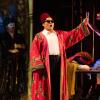
In the opening scene of The Righteous, composer Gregory Spears and librettist Tracy K. Smith’s new opera, several characters are armed and out on a hunt. Paul (portrayed by bass-baritone Greer Grimsley) asks David (baritone Michael Mayes), his son’s childhood best friend, now an adult and a preacher, to say a prayer.
David kneels, facing the audience, and begins to pray. A few minutes later, he is in the midst of a full-scale personal confession of his weaknesses. The other characters have wandered off into the distance, chatting among themselves.
I, too, found my attention wandering during David’s prayer. Those first few minutes of The Righteous encapsulate two major issues in an opera that’s full of them: arias that are too long and meandering and a plot that tries to do too much.
The Righteous, which runs three hours, with one intermission, was commissioned by Santa Fe Opera and premiered on July 13. I saw the Aug. 7 performance and also heard the radio broadcast, which is streaming until Sept. 12. (You can stream Santa Fe’s other 2024 productions for a limited time as well.)
The Righteous is about the intersection of historical events of the late 1970s to the early 1990s, framed as a modern retelling of the biblical story of David, here a young Christian preacher. Each of the main characters loosely parallels a biblical figure.
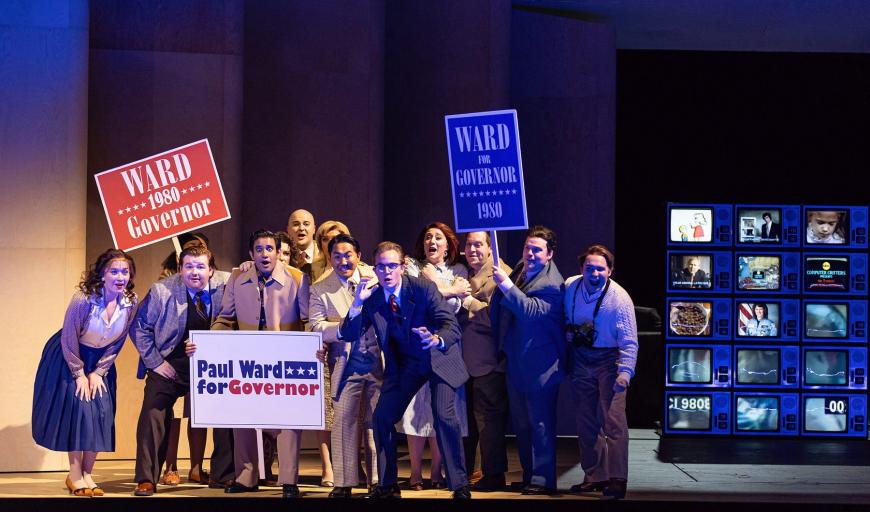
The libretto encompasses a plethora of issues, including religion, politics, corporate power, feminism, social justice, domestic violence, gay love, and heterosexual marriage. It is overlong, burdened with too many characters and events. And one might question the wisdom of taking a distinctly Jewish story, in which the biblical David is a military hero, and moving it to a Christian context.
Over the course of The Righteous, David journeys from charismatic preacher to pragmatic, unfeeling politician, marrying twice along the way. His first wife is Michele (mezzo-soprano Jennifer Johnson Cano), his friend Jonathan’s sister, whom he feels called to marry by God. His second wife is his parishioner Sheila (soprano Elena Villalón), who leads a women’s group at his church and with whom he has an affair. David becomes a politician almost by accident, running to succeed his father-in-law Paul, governor of the state where they live, after Paul dies in office.
David disappoints or fails nearly everyone around him. There’s the extramarital affair. There’s the fact that during the early AIDS crisis, he calls on gay men to repent rather than offering compassion and love, angering Jonathan (countertenor Anthony Roth Costanzo), who has romantic feelings for David. David’s abandonment of his youthful ideals disappoints Sheila, who might be moving on from him by the end of the opera. His political stances are an affront to the young Black pastor Jacob (bass-baritone Nicholas Newton) and Sheila’s daughter, Shannon (soprano Jazmine Saunders).
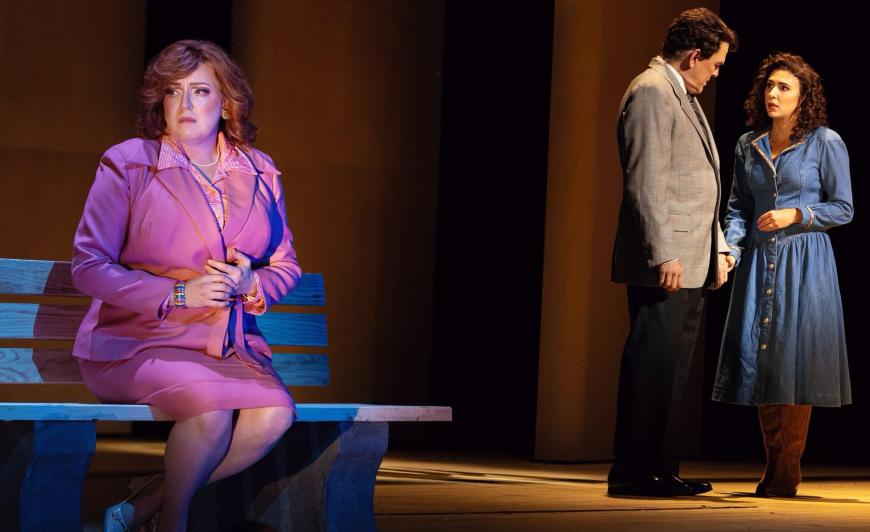
Years are passed over, and you’re still left with questions about the fates of some characters. What happens to Marilyn (soprano Wendy Bryn Harmer) after her husband Paul’s death? She’s a sympathetic, plainspoken character whom we never see after the funeral. What about Michele’s life between the end of her marriage to David and the close of the opera, when she and Sheila meet for the first time in many years? Michele has become a lawyer, but we know little of her life beyond her work.
The sprawling libretto — and I’ve omitted many details — lacks focus and is full of wordy, conversational text. It might work if the music were better, but Spears’s setting of these passages is dull and awkward, while the dominant tone of the many arias is soaring, inspirational uplift, regardless of the situation. Maybe this is a byproduct of the religious focus of the plot, but surely there could be more variation in harmonic profile and tempo — there is far too much moderato.
This sameness is particularly true of the arias for Michele and Sheila. They are gracefully written for the voice and will surely become regular audition pieces, but the characters lack musical distinctions between their very different situations. In addition, Smith’s text includes arias structured as villanelles — she’s a Pulitzer Prize-winning poet — yet Spears’s music obscures the form.
There is one exception to the general sameness. The choral music has both power and beauty and is what I would most like to hear again. Conductor Jordan de Souza moved the opera along as well as he could; he’s not responsible for the score’s problems.
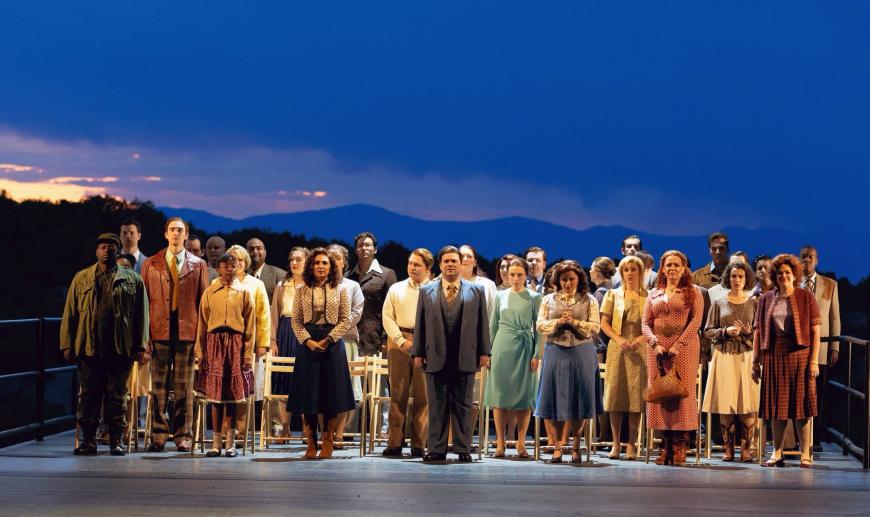
The performers deserve high praise. It’s a shame Grimsley didn’t have more to do as Paul, and it was strange that his wig and costumes made him look like a cross between conductor Michael Tilson Thomas and film director Barry Sonnenfeld. Mayes was impressive, vocally and dramatically, as David.
Tenor Brenton Ryan was appropriately slimy as Paul’s political associate, CM. Newton was moving as Jacob, as was tenor Andrew Turner as Eli, Sheila’s abandoned first husband. Among the men, only Costanzo disappointed. He was in wobbly voice the night I saw him. Additionally, he seemed badly miscast. Between his small stature and countertenor range, it felt as though Jonathan was a child rather than a grown man.
Cano, Villalón, and Harmer all sang with a vibrant, shimmery tone well suited to the music Spears composed for them. You have to wonder whether their tonal similarities helped give rise to the score’s sameness. Saunders and soprano Natasha Isabella Gesto (as Shannon’s college roommate) were both charmingly youthful (both singers are 2024 Santa Fe Opera apprentices). The Santa Fe Opera Chorus was superb.
Mimi Lien’s handsome set, consisting of rotating wooden panels framing the entire stage, transformed readily into a church, an office, the interior of different homes, and a women’s shelter. Kevin Newbury directed the large cast efficiently, though without any telling insights. The complex and sometimes messy stage action might well have been inevitable. After all, what’s a director to do when faced with a scene where a soprano is downstage singing about the state of her marriage, her husband and his paramour are far upstage singing a duet, and the soprano’s father is silently collapsing in between from a fatal heart attack?
L’elisir d’amore
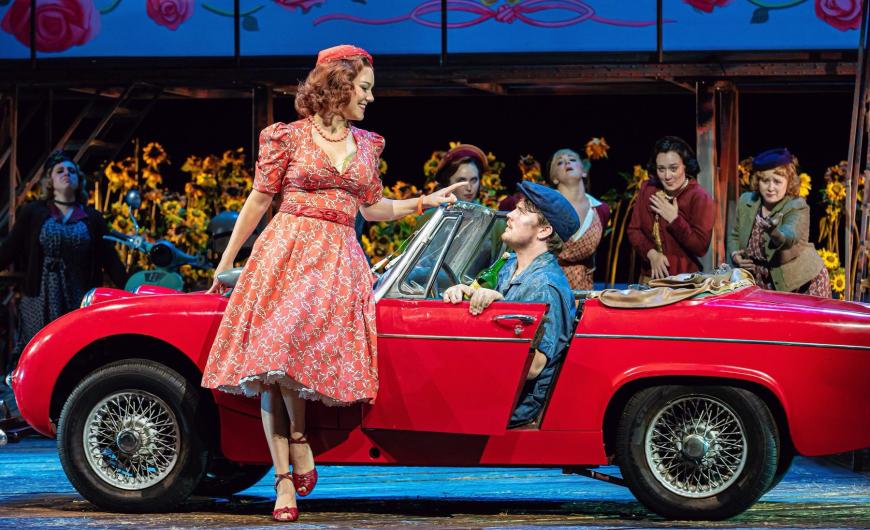
Fortunately, the other productions in Santa Fe this season were more successful. Take Stephen Lawless’s charming staging of Gaetano Donizetti’s L’elisir d’amore (The elixir of love). Sets and costumes by Ashley Martin-Davis, good singing and acting, and exceptional conducting combined to make this very silly opera — about cheap Bordeaux wine sold as a love potion — a warm-hearted winner.
For this production, Lawless relocates the action to 1945, right after World War II. Sergeant Belcore is a member of the U.S. Army (which is presumably still occupying Italy). The unit set is sufficiently varied, able to hold your attention, with a grocery store on the left and Nemorino’s garage on the right.
Motor vehicles are a recurring theme. The start of this production has Nemorino working on a partially disassembled two-seater sports car, looking cute but slightly greasy. By the end of the opera, he is cleaned up, the car is fully assembled, and he and Adina have had an intimate encounter in it. There’s a U.S. Army jeep, and a non-singing priest arrives on a scooter to marry Adina and Belcore (or rather Nemorino).
Bel canto opera is all too easy to conduct with a certain sameness, but Roberto Kalb avoided this trap, leading with a sure hand and a finely tuned sense of pacing and structure. The frothy numbers bubbled away, the more melancholy floated, and the opera’s energy never flagged.
Jonah Hoskins sang an adorable Nemorino with a flexible, slightly reedy tenor and just the right amount of shyness. Soprano Yaritza Véliz has a darker sound than you usually hear from an Adina and sometimes seemed a bit too characterful for such a slight work. Baritone Alfredo Daza was marvelously funny as the con man Dulcamara, though his vibrato has loosened to the point of wobble. Baritone Luke Sutliff was an amusing Belcore, soprano Cadie J. Bryan a sweet Giannetta.
Don Giovanni
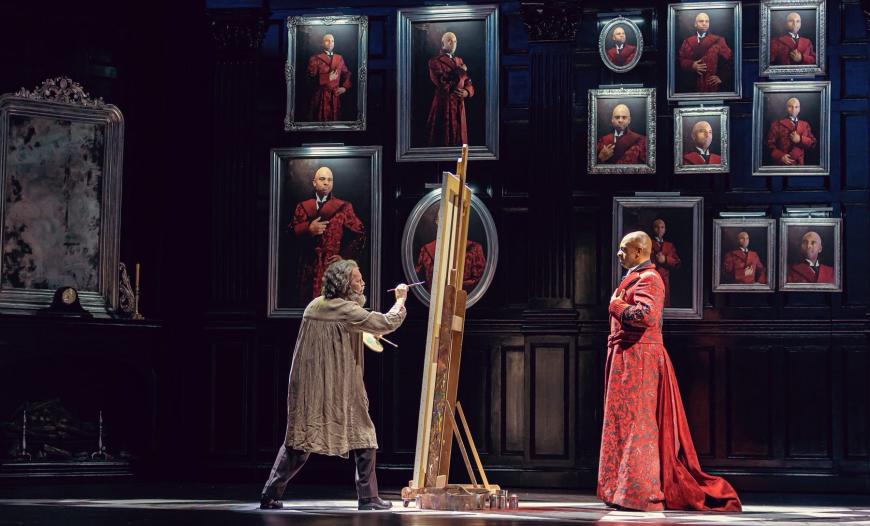
Director Stephen Barlow has moved Don Giovanni to 1880s London, the Victorian era, on the grounds that the social stratification of the period is relevant to Mozart’s opera — and to bring it into the time of Oscar Wilde’s The Picture of Dorian Gray, “the other DG.”
Well, OK: During the overture, you see Don Giovanni’s study, where a painter, who emerges briefly from behind a huge easel, is painting the Don (bass-baritone Ryan Speedo Green). Hung on the walls of the study are more than a dozen portraits of the roue in different poses, clothed in the same brocaded dressing gown. Perhaps these paintings are intended to keep Don Giovanni youthful forever, but he, of course, will be dead by the end of the opera.
So they serve to emphasize his narcissism and self-regard, as well as set up another association. The portraits, particularly the full-length one in progress during the overture, resemble John Singer Sargent’s Dr. Pozzi at Home. (Pozzi was a notorious womanizer whom Sargent painted in 1881, exhibiting the portrait the following year at London’s Royal Academy).
Barlow’s concept works reasonably well and includes some clever staging. With the arrival of Donna Elvira (mezzo-soprano Rachael Wilson), we see the front-desk area of a hotel, complete with a couple of clerks playing a part in the reimagined action. We see a maid sweeping the floor and luggage moving through the lobby. A sofa provides a handy location for a few arias. When Leporello (bass-baritone Nicholas Newton) sings “Madamina” (the catalog aria) to Elvira, he opens the book of Don Giovanni’s conquests, and a wall map unfolds showing the geographic location of each of them. Elvira nearly faints at the sight.
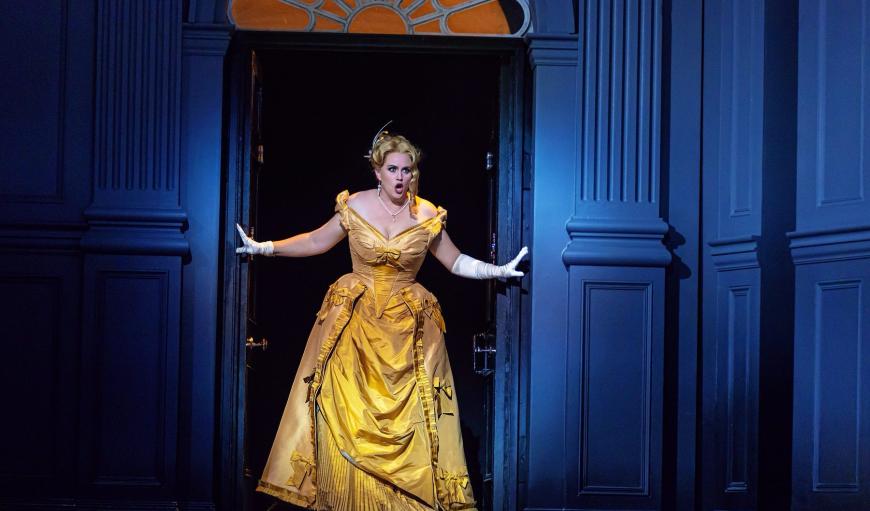
Yannis Thavoris’s moody sets look great and make scene transitions comparatively easy. Walls radiating from a central point swing to reveal various outdoor scenes, the hotel lobby, and Don Giovanni’s study. Christopher Akerlind’s lighting design complements the sets and Thavoris’s Victorian-style costumes.
On the other hand, some scenes in this production fall flat or are inappropriate for the period. When Donna Anna (soprano Rachel Willis-Sørensen) tussles with Don Giovanni as she tries to escape him, there’s little tension. Don Giovanni’s fight with the Commendatore (bass Soloman Howard, in gravelly voice but with a strong physical presence) is also visually weak — because they’re wrestling over a gun rather than both armed with swords. It’s hardly believable that Don Ottavio (tenor David Portillo) would be allowed in Donna Anna’s bedroom. While the surprise of a male hotel clerk quietly coming on to Don Giovanni toward the end of the serenade “Deh, vieni alla finestra” is charming, such an action would have been hugely risky for a gay man in 1880s England.
One of Barlow’s staging decisions is so ludicrously bad that it will live forever in memory. At the end of the opera, the Commendatore, returning from the dead, makes an impressive entrance through the life-size portrait of Don Giovanni. The two fight, and instead of Don Giovanni being dragged off to hell, he collapses on the floor of his study, his arms outstretched in a T — just like Baron Scarpia. Next, Elvira takes candlesticks from a table and places them, as in Tosca, in the canonical locations alongside Giovanni’s head. Then she falls on the corpse, weeping copiously.
Now, Elvira has ambiguous feelings about Don Giovanni. She wants revenge, but she also wants to be married to him and relive their three days in Burgos. Weeping over the body is certainly plausible. But Tosca’s feelings about Scarpia are unambiguous: She hates him and wants him dead. Both men are evil, but the visual correspondence here, given how differently Elvira and Tosca feel, seemed wholly inappropriate.
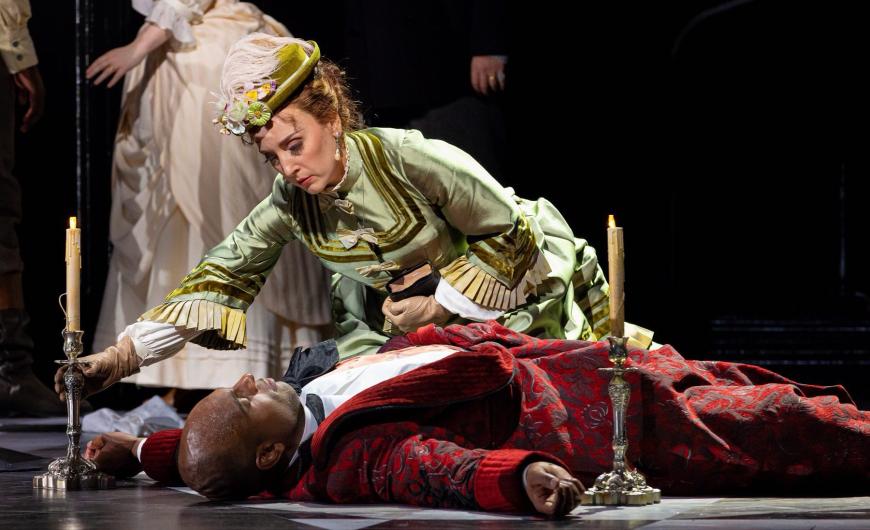
By and large, though, Barlow’s direction of the individual singers was quite good, and most of the principals were excellent. Green’s height, good looks, and beautiful voice made him a sexy and credible Don Giovanni. As he takes on heavier roles — he will be Wotan in Santa Fe’s production of Richard Wagner’s Die Walküre next year — he might be losing some ability to lighten his voice for Mozart. The serenade could have had more seductive delicacy.
Willis-Sørensen, one of two sopranos who took over Donna Anna following the originally cast singer’s late withdrawal, has a voice that, if anything, has grown in size, while retaining a golden beauty from top to bottom. She is a tall, statuesque woman, the very embodiment of nobility. One could have wished for a better Don Ottavio for her: Portillo’s smallish tenor sounded thin and pushed beyond its limits, particularly in contrast to Willis-Sørensen’s tonal grandeur. Giving him both of Don Ottavio’s arias slowed down the action, though Santa Fe Opera Music Director Harry Bicket’s middle-of-the road tempos did also drag intermittently during Act 2.
Newton was a smooth and entertaining Leporello, retaining plenty of dignity even when cowering in fear. Wilson’s Elvira was extremely funny; I particularly appreciated the hotel staff fleeing in fear of her temper. Wilson had all the agility and range that Elvira’s music requires, but her voice had an unpleasant squeezed quality. Soprano Liv Redpath sang Zerlina with crystalline purity, and bass William Guanbo Su was a fine Masetto.
Der Rosenkavalier
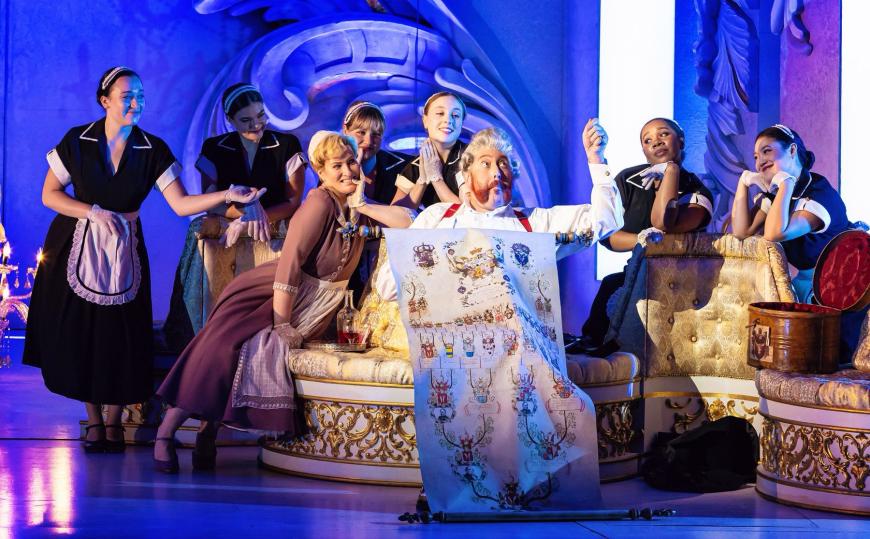
Richard Strauss has long been a specialty of Santa Fe Opera, and the company did itself proud with this year’s production of Der Rosenkavalier, the composer’s second collaboration with librettist Hugo von Hofmannsthal. The opera’s blend of farcical humor and autumnal melancholy, its contrast of old love and new, and, of course, its fabulously beautiful music have made it perhaps the most loved of Strauss and Hofmannsthal’s collaborations.
Director Bruno Ravella’s production moves the opera to the 1950s. You would think this would remove many of the social constraints on the Viennese nobility, but Der Rosenkavalier is a fantasy of aristocratic life, not reality. The physical production works well and has a kind of restrained beauty — except for the last act’s inn, which is hilariously over the top.
The costumes, too, reflect the midcentury. Valzacchi and Annina look like they’ve dropped in from the French Riviera or perhaps Paris. Baron Ochs’s Act 1 plaid suit with argyle socks is as absurd as the character himself. Sophie’s diaphanous pink frock in Act 2 is perfect for a teenage girl. The Marschallin’s sumptuous gowns ideally suit the character’s inherent dignity. Octavian is in dress uniforms — when he hasn’t just tumbled out of the Marschallin’s bed or put on a dress to hide from or seduce Ochs.
This Rosenkavalier was by and large strongly cast. Soprano Rachel Willis-Sørensen was a magnificent Marschallin, projecting wisdom and maturity with her majestic presence, personal beauty, and resplendent voice. As Sophie, the 15-year-old who’s been betrothed to Ochs, soprano Ying Fang was youthful in manner and sweet in voice and also foot-stamping and rebellious. Bass Matthew Rose played Ochs as the ridiculous, ill-behaved boor that he is without slipping into caricature, a fine balancing act. Baritone Zachary Nelson’s Faninal was comical without too much exaggeration.

Alas, though she handled the boyish physicality of Octavian well, mezzo-soprano Paula Murrihy was vocally the weakest of the major characters, short at the top of her range and without much vocal bloom. Nonetheless, the character’s duets with the Marschallin and Sophie, as well as the ravishing Act 3 trio, all sounded wonderful. Tenor David Portillo’s parched Italian Singer was no more successful than his Don Ottavio. Veteran tenor Gerhard Siegel and mezzo-soprano Megan Marino were excellent as the conspiratorial Valzacchi and Annina, respectively.
The many smaller roles were all ably filled, largely by Santa Fe’s 2024 apprentices. Karina Canellakis conducted sympathetically and supportively, handling the big orchestra with authority but without ever undermining or overwhelming the singers.


